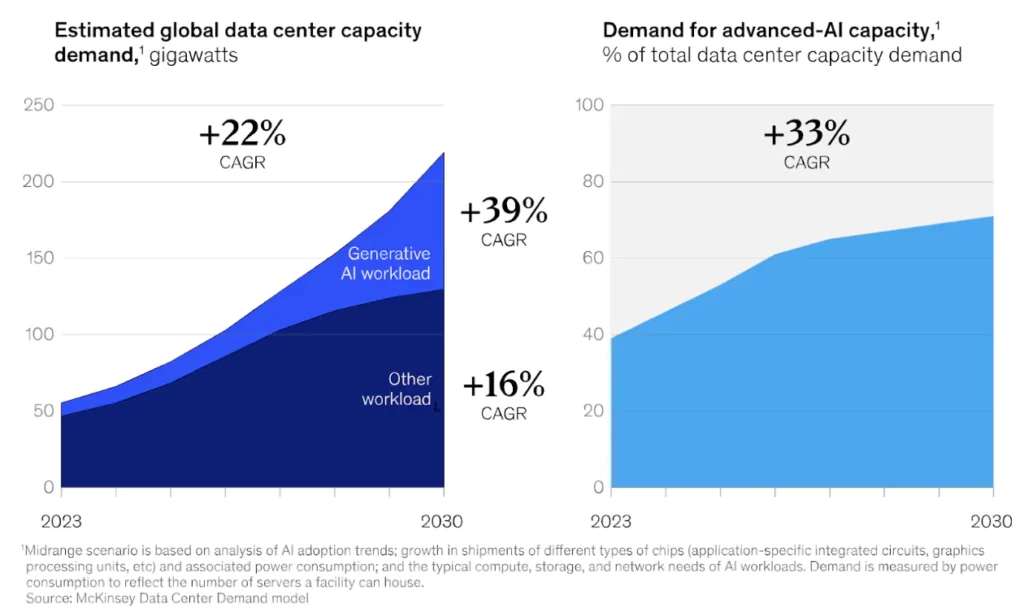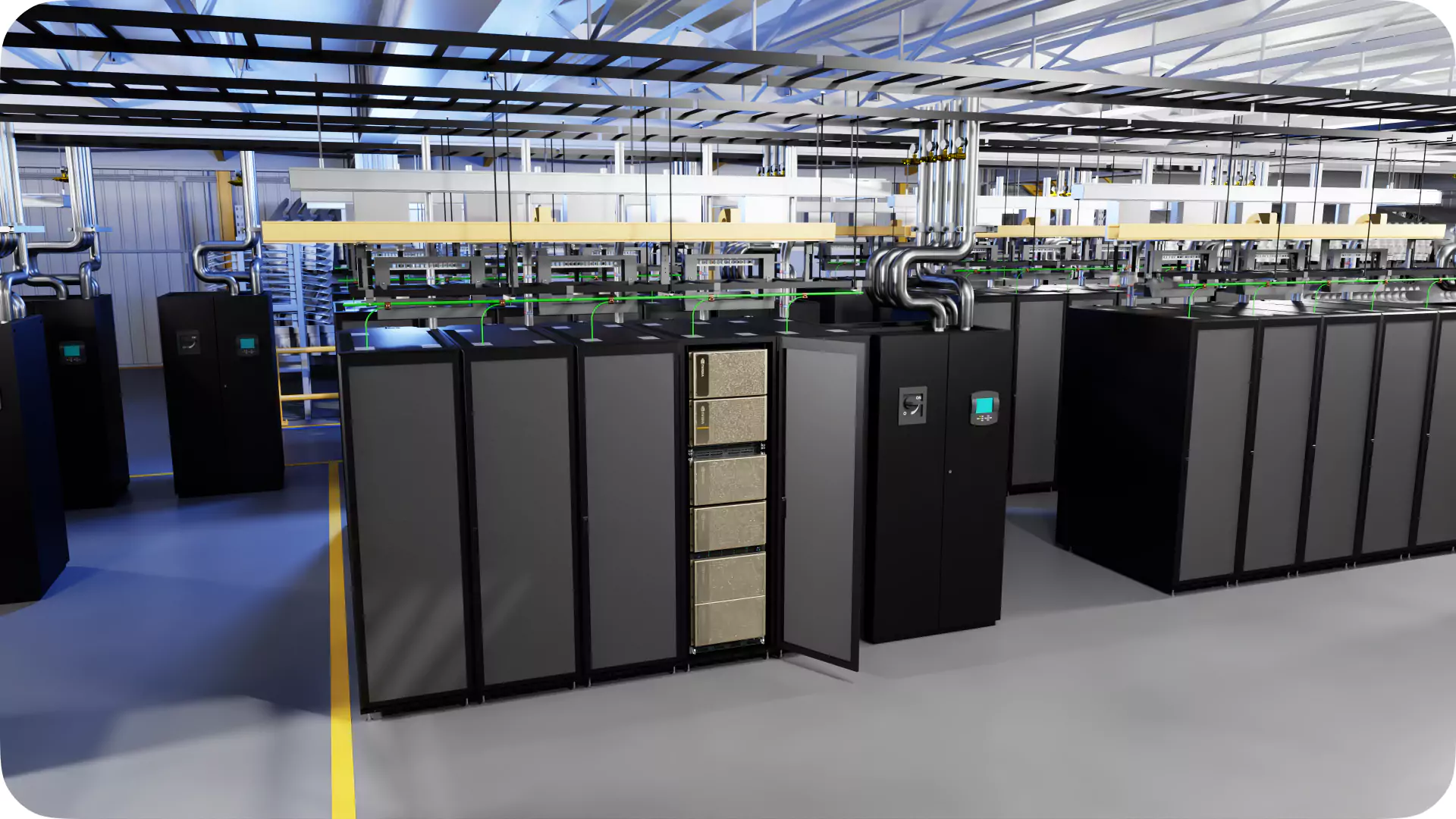Next-gen data centers are becoming essential infrastructure, especially as the use of generative AI continues to grow.
Meeting the computing demands of tomorrow’s models requires not only more capacity but also a complete rethink of how data centers are designed, powered, and deployed.
The growing demand for next-gen data centers
The global demand for data centers is projected to rise at an annual rate of up to 22%, reaching up to 219 gigawatts (GW) by 2030, according to McKinsey. In a more aggressive growth scenario, that figure could climb as high as 298 GW —nearly five times today’s capacity.

Source: McKinsey & Company.
More importantly, McKinsey’s analysis suggests that demand for AI-ready data center capacity will rise even faster, at an average rate of 33% per year between 2023 and 2030 in a midrange scenario. This means that by the end of the decade, around 70% of total data center demand is expected to come from facilities capable of hosting advanced AI workloads. These future energy demand forecasts do take into account that servers and hardware are becoming more energy-efficient. However, total energy demand is still expected to grow significantly.
While cloud giants still lead the way in terms of AI-ready data center capacity, enterprises are increasingly stepping into the ring, building and training their own AI models using internal data. This shift is fueling demand for next-gen data centers, as well as adding new complexity to how data centers are designed.
What makes a data center “next-gen”?
A “next-gen data center” is one that uses the latest technologies to deliver the highest levels of performance, efficiency, and scalability. These facilities are purpose-built to support high-density, AI driven workloads. Designing a next-gen data center goes beyond simply adding faster chips or more services. It requires a holistic, strategic approach—one that thoughtfully integrates factors such as power, cooling, network infrastructure, and site selection into an adaptable and future-proof system.

Source: McKinsey & Company.
"While cloud giants still lead the way in terms of AI-ready data center capacity, enterprises are increasingly stepping into the ring, building and training their own AI models using internal data."
– Sami Heinonen. CTO of XR, Younite AI
Challenges in designing next-gen data centers
The combination of high energy demands, dense workloads, and varied AI use cases poses unique challenges for next-gen data center design. Below, we explore how companies are solving for these complexities, and include examples from NVIDIA’s Digital Blueprint for Building Next-Gen Data Centers to illustrate practical solutions.
Data center location
As data center power demands soar, traditional American hubs like Northern Virginia and Santa Clara are facing grid capacity constraints and infrastructure delays. So where does that leave operators?
In the United States, many are now looking to remote locations such as Indiana and Wyoming, where power is more abundant and low latency is less critical for AI training workloads. Meanwhile, across Northern Europe, companies like Google are capitalizing on naturally cool air and existing infrastructure by repurposing paper mills with existing hydroelectric energy sources, such as their facility in Hamina, Finland. Others are collaborating, such as K-Supermarket Mankaa and the Nordic atNorth data center. Located on adjacent plots in Mankkaa, Espoo, waste heat from the data center will be used to cover almost all the heating energy needed by the store.
NVIDIA’s showroom demo highlights how simulation can validate and optimize these new locations. Using lidar scanning and 3D mesh modeling tools—like NavVis VLX and Prevu3D—NVIDIA created a digital twin of an existing facility. This allowed them to simulate everything from space constraints to airflow and cabling before creating anything physical.
Power infrastructure
AI-ready data centers are redefining what high capacity means. Goldman Sachs Research estimates the global data center market currently consumes around 55 GW of power, with demand expected to reach 84 GW by 2027. To meet these demands, operators are increasingly building near power plants or adopting off-grid energy sources to avoid transmission bottlenecks and keep pace with demand. In Omniverse, NVIDIA engineers used PATCH MANAGER to visualize and plan cabling and power routing within the digital twin, ensuring accurate layouts before deployment.
Mechanical system design
Cooling high-density AI clusters requires more than traditional air systems. NVIDIA integrated industry-standard tools like Cadence Reality and Ansys directly into its Omniverse-powered digital twin. This central integration allowed engineers to simulate and optimize airflow and cooling performance in a unified, photorealistic environment. Then, the engineers could assess thermal behavior in a fully accurate 3D model before installing the physical systems, improving confidence in performance and energy efficiency.
Electrical system design
AI workloads are influencing the design and layout of electrical infrastructure. In its digital twin demo, electrical infrastructure was visualized and aligned using OpenUSD within Nvidia Omniverse. This created a single source of truth for CAD interoperability and cable routing. Teams could then precisely balance power distribution needs with space constraints before implementing changes in the physical environment.
Ongoing operations and maintenance
The value of a data center digital twin doesn’t end after deployment. In the maintenance phase, live server data feeds into the digital twin environment. This allows operators to visualize the current status of equipment in real time. In NVIDIA Omniverse, the live visualization helps operators quickly understand performance, identify issues, and make informed decisions, whether it’s about capacity planning, environmental anomalies, or equipment failure. And because the digital twin spans the full lifecycle, from marketing and design to upgrades and decommissioning, it becomes a reusable, renewable asset that supports every phase of the data center journey.
Partner with Younite
Building on NVIDIA’s digital blueprint for next-generation data centers, Younite is redefining what’s possible in next-gen data center development. By integrating cutting-edge tools for simulation, design and infrastructure planning, Younite provides advanced solutions for rapid deployment, improved performance, and increased energy efficiency in their data center projects.
Interested in designing, simulating and optimizing your data center with Younite? Let’s start a conversation today.
Related Content

BLOG
What is a digital twin and how does it maximize ROI?
As technology evolves, the boundary between the real world and the virtual world has blurred to the point where it may no longer exist. Among the most transformative innovations in this space is the concept of digital twins...
About the author
Sami Heinonen
Sami is a visionary technology leader and innovator with 30+ years of experience in the internet and immersive realities. As CTO of XR at Younite AI, he specializes in NVIDIA Omniverse and XR, bridging cutting-edge technology with real-world use cases.

